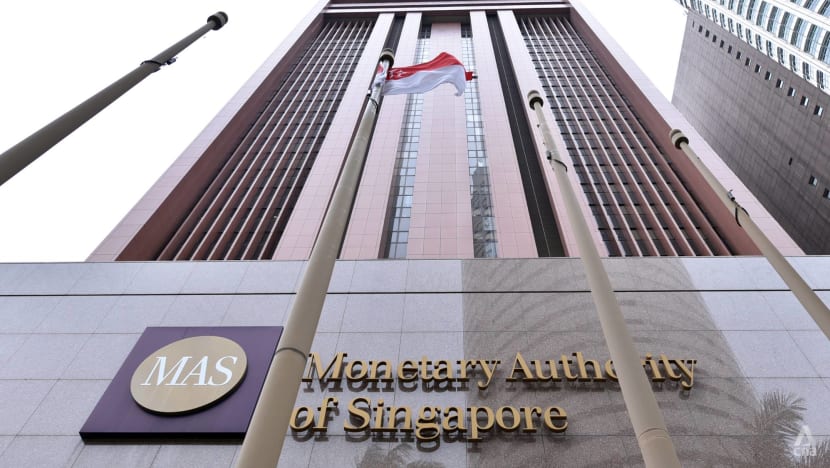MAS tightens monetary policy for the fifth time in a year to dampen inflation
The central bank said that a further tightening of monetary policy is needed to help “ensure that price pressures are dampened over the next few quarters”.

File photo of the Monetary Authority of Singapore building on Shenton Way. (File photo: CNA/Jeremy Long)
SINGAPORE: The Monetary Authority of Singapore (MAS) has tightened monetary policy for the fifth time in a year, allowing a further strengthening in the Singapore dollar to help dampen inflation.
In its half-yearly monetary policy statement released on Friday (Oct 14), the Singapore central bank said it will re-centre the mid-point of the Singapore dollar nominal effective exchange rate (S$NEER) policy band “up to its prevailing level”.
The slope and width of the band were left unchanged.
In general by tightening monetary policy, MAS is effectively allowing the Singapore dollar to appreciate. This makes imports cheaper and in turn helps to put a lid on the rise in prices of goods and services here.
The central bank noted that the global economy faces high inflation and lower growth next year, while Singapore’s economic growth will "come in below trend" in 2023 amid intensified downside risks.
At the same time, core inflation is expected to remain elevated over the next few quarters, with risks still tilted to the upside.
“MAS has assessed that, on balance, a further tightening of monetary policy is needed to help ensure that price pressures are dampened over the next few quarters,” it said.
This marks MAS’ fifth policy tightening move in a row.
It first tightened policy in October last year when it slightly raised the slope of its exchange-rate based policy band to allow the Singapore dollar to appreciate at a slightly faster pace.
It then followed up with another steepening of the slope in January, surprising markets with an inter-meeting adjustment, before making a two-in-one move in April to raise the slope while re-centering the mid-point of the policy band.
MAS re-centred the mid-point again in an off-cycle move in July as a “further calibrated step” to tame inflation.
The central bank described its latest announcement as “building on past tightening moves” and will help to further reduce imported inflation and curb domestic cost pressures.
“The policy stance will help dampen inflation in the near term and ensure medium-term price stability, providing the basis for sustainable economic growth,” it said.
“MAS will continue to closely monitor global and domestic economic developments, amid heightened uncertainty on both the inflation and growth fronts.”
HOW SINGAPORE MANAGES ITS MONETARY POLICY
Singapore's central bank has a unique approach to monetary policy.
Unlike most central banks that manage monetary policy through the interest rate, it uses the exchange rate as its main policy tool because Singapore is an open economy that depends heavily on trade.
This refers to the S$NEER – the exchange rate of the Singapore dollar managed against a trade-weighted undisclosed basket of currencies from Singapore’s major trading partners.
MAS allows the S$NEER to float within an unspecified band. Should it go out of this band, it steps in by buying or selling Singapore dollars.
The central bank also changes the slope, width and mid-point of the band when it wants to adjust the pace of appreciation or depreciation of the local currency based on assessed risks to Singapore’s growth and inflation.
With Singapore buying almost everything it consumes from abroad, a stronger Singapore dollar will help convert foreign prices of imports into lower local prices. The flip side of that, however, is a possible hit on the competitiveness of the country's exports.
The three policy levers of MAS
1. The slope
This is probably the most common tool used by the MAS to adjust the band.
Simply put, the slope determines the rate at which the Sing dollar appreciates. If the slope is reduced, this means the local currency will be allowed to strengthen at a slower pace. It strengthens at a faster pace when the slope is increased.
2. The mid-point
This is a tool generally reserved for “drastic” situations, such as recessions, when the outlook for growth and inflation sees an abrupt and rapid change.
Compared to tweaks in the slope, an adjustment in the mid-point either upwards or downwards is likely to yield a quicker and bigger impact on the currency, economists have said.
3. The width
This controls how far the Sing dollar can fluctuate. This means the wider the band, the more volatile the currency can be.
It is typically reserved for periods of increased uncertainties or volatility.
For instance, the band was widened in October 2001 after the Sep 11 terrorist attacks in the United States led to extreme volatility in the financial markets. More recently in October 2010, the width was also widened slightly “in view of the volatility across international financial markets”.
INFLATION PRESSURES TO PERSIST
Latest data showed consumer prices in Singapore continuing to climb in August on the back of stronger increases in the prices of food and services.
Core inflation, which excludes accommodation and private transport costs, hit 5.1 per cent year-on-year, up from 4.8 per cent in the previous month and marked its highest level since it touched 5.5 per cent in November 2008.
August’s headline consumer price index (CPI), or overall inflation, came in at 7.5 per cent year on year, surpassing the 7 per cent in July.
MAS said on Friday that it expects core inflation to “stay around 5 per cent” for the rest of the year, and into early 2023.
It noted that the confluence of demand and supply factors behind higher-than-expected price increases in the third quarter is set to persist. A tight domestic labour market will support robust wage increases, while imported inflation will remain significant across a range of intermediate and final goods.
For the whole of 2022, the central bank expects core inflation to average around 4 per cent while headline inflation is projected to be around 6 per cent.
These are at the upper end of its earlier estimates. MAS had previously predicted full-year core inflation to be between 3 to 4 per cent, and headline inflation to be at 5 to 6 per cent.
Moving into 2023, cost pressures which have been accumulating along domestic and global supply chains will continue to pass through to consumer prices.
“Even as prices of energy and food commodities have moderated from their peaks, businesses will face higher utility and raw material costs as contracts are renewed,” MAS said.
“The pace of domestic unit labour cost increases should ease over the course of 2023, as labour demand and supply rebalance, but remain above its historical average.”
The one-percentage point increase in the Goods and Services Tax (GST) – from 7 per cent to 8 per cent – will have a “one-off step-up” in price levels, but the effect on inflation should be “transitory”, it added.
Taking into account all factors including the GST increase, core inflation for 2023 should come in at 3.5 to 4.5 per cent while headline inflation is seen at 5.5 to 6.5 per cent.
Excluding the one-off effects from the GST hike, core inflation would “remain above trend” at 2.5 to 3.5 per cent and headline inflation at 4.5 to 5.5 per cent.
MAS warned of “upside risks” to these forecasts, including from fresh shocks to global commodity prices and second-round effects associated with a prolonged period of high inflation.
The monetary policy decision comes alongside official advance estimates that showed the Singapore economy expanded 4.4 per cent year-on-year in the third quarter, easing slightly from the 4.5 per cent growth in the earlier quarter.
On a quarter-on-quarter seasonally adjusted basis, gross domestic product grew by 1.5 per cent, a turnaround from the 0.2 per cent contraction in the earlier three months.


















